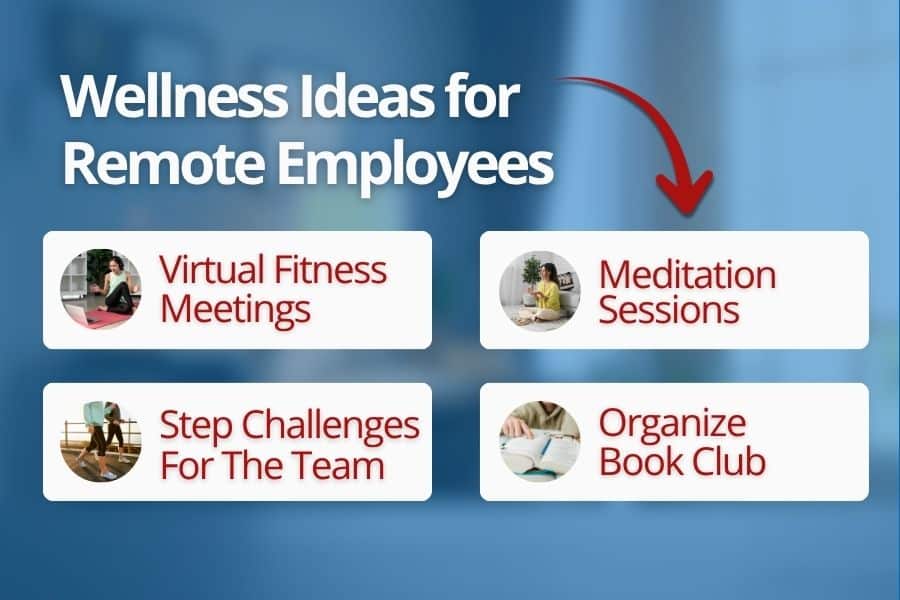Remote work has completely changed how companies think about employee wellness. Without shared offices or in-person activities, keeping employees active, engaged, and mentally healthy requires a fresh approach.
Whether your organization is in Denver, Tampa, or managing a hybrid team across states, a well-designed wellness program can help bridge the gap between work and wellbeing.
This guide explores realistic employee wellness program ideas for remote teams that are affordable, inclusive, and effective. You’ll find practical ideas for physical, mental, and social health, plus advice on how to maintain engagement and measure success over time.

Why Employee Wellness Program Ideas for Remote Teams Matter
Wellness programs used to center around office gyms or in-person events. Today, teams work from living rooms, coffee shops, and coworking spaces. That shift means wellness must be built into company culture, not tied to a location.
Prioritizing wellness for remote teams leads to:
- Healthier employees: Less burnout, more energy, better focus.
- Stronger teamwork: Shared goals strengthen bonds, even virtually.
- Lower turnover: Employees who feel valued stay longer.
- Better performance: Healthy, happy employees are more productive.
Remote workers thrive when their employer supports both their work and their wellbeing.
Common Challenges of Remote Team Wellness
Designing effective employee wellness programs for remote teams comes with challenges such as:
- Screen fatigue: Hours of video calls lead to exhaustion.
- Isolation: Fewer opportunities for casual connection or support.
- Inconsistent routines: Work-life boundaries can blur.
- Unequal participation: Some employees may feel left out due to time zones or preferences.
Recognizing these challenges helps companies choose wellness ideas that are flexible and fair for everyone.
The Foundation of Successful Remote Wellness Programs
Before launching new initiatives, build a foundation that ensures participation and long-term success.
Inclusivity:
Offer options that fit various fitness levels, lifestyles, and comfort zones.
Flexibility:
Let employees choose when and how to participate. Recorded sessions or asynchronous challenges work best.
Consistency:
Run programs regularly instead of one-time events. Routine builds engagement.
Communication:
Announce programs clearly, celebrate wins, and gather ongoing feedback. Poor communication about program benefits—for employees, their families, and workplace productivity—can reduce engagement and impact. Clear messaging drives participation and better outcomes.
A good foundation creates a culture where wellness feels natural, not forced.
Employee Wellness Program Ideas for Remote Teams
The table below summarizes top wellness ideas for remote employees across physical, mental, and social categories.
| Category | Wellness Idea | Purpose and Benefit |
|---|---|---|
| Physical | Virtual fitness or yoga classes | Keeps employees active and improves posture, strength, and focus. |
| Physical | Daily step or hydration challenges | Adds accountability and friendly competition. |
| Mental | Mindfulness or guided meditation | Reduces anxiety and promotes calmness. |
| Mental | Mental health check-ins | Encourages open communication and reduces isolation. |
| Social | Virtual coffee breaks or trivia events | Builds stronger connections across teams. |
| Holistic | Monthly wellness workshops | Educates and inspires employees on nutrition, sleep, or stress. |
| Holistic | Recognition for participation | Encourages consistency and appreciation. |
Physical Wellness for Remote Employees
Movement is one of the most effective ways to boost mood and energy. Encourage physical activity throughout the day with simple, accessible ideas.
Virtual Classes:
Host weekly online workouts such as yoga, pilates, or low-impact strength training. Short sessions between meetings help prevent fatigue.
Micro-Breaks:
Encourage employees to take 5-minute stretch breaks every hour. Small reminders through company chat platforms help.
Wellness Challenges:
Launch company-wide fitness challenges that promote movement. For example, challenge teams in Denver and Tampa to see which group logs more steps or active minutes over a month.
Home Office Ergonomics:
Offer tips or quick training sessions on setting up a safe, comfortable workspace to prevent back and neck pain.
Mental and Emotional Wellness for Remote Teams
Emotional wellbeing is often overlooked but essential for long-term productivity. Programs that support mental health reduce burnout and turnover.
Mindfulness and Meditation:
Encourage employees to start or end their day with guided breathing or meditation sessions.
Gratitude Journals:
Ask team members to write down one positive moment from each day or week. This simple practice helps maintain perspective.
Confidential Support:
Provide access to mental health professionals or wellness coaches for private sessions.
Flexibility and Rest:
Offer occasional “wellness afternoons” or optional mental health days to encourage rest and balance.
Social and Community Wellness Programs
Social wellness builds belonging and strengthens relationships, which are key ingredients for remote teams.
Virtual Social Events:
Plan fun, informal activities like online trivia, coffee breaks, or team lunches.
Wellness Teams or Ambassadors:
Create small committees to lead wellness efforts and share updates.
Charity or Volunteer Opportunities:
Encourage teams to participate in remote volunteering, such as mentoring students or supporting local food drives in Denver or Tampa.
Peer Recognition:
Highlight employees who participate consistently in wellness programs. Recognition motivates others to join in.
Holistic and Preventive Wellness Approaches
Holistic wellness goes beyond fitness, it supports employees’ physical, emotional, and financial wellbeing.
- Educational Workshops: Monthly sessions on topics like nutrition, better sleep, or financial health.
- Virtual Health Screenings: Partner with telehealth providers for preventive care and advice.
- Healthy Habits Rewards: Offer small incentives for consistency, such as digital gift cards or time off.
- Wellness Resource Library: Create a shared folder with helpful videos, articles, and checklists.
These initiatives show employees that wellness is about their whole life, not just their work hours.
Low-Cost Employee Wellness Program Ideas for Remote Teams
A great wellness program does not need a large budget. Many impactful ideas cost little or nothing at all.
- Share wellness tips in company newsletters.
- Encourage walking meetings instead of video calls.
- Create hydration challenges to promote healthy habits.
- Provide recognition for consistency instead of costly rewards.
According to workplace wellness research, programs that emphasize inclusion and simplicity often have higher engagement than those focused on expensive perks.

Keeping Employee Wellness Programs Engaging
Sustaining engagement is where many wellness programs fail. Keep your team interested by mixing variety and personalization.
Rotate Activities: Introduce new challenges or themes each quarter.
Collect Feedback: Ask employees what’s working and what’s not.
Lead by Example: When leaders participate, employees follow.
Share Results: Publish participation stats or team success stories.
Wellness should evolve alongside your team’s needs, not stay static.
Measuring Success in Employee Wellness Programs
To evaluate success, use measurable and human-centered metrics such as:
- Participation rates in activities
- Employee feedback and satisfaction surveys
- Reported energy levels or reduced stress in surveys
- Fewer sick days or absenteeism
Regular measurement helps refine your program over time.
When to Partner with a Professional Wellness Provider
If your team is struggling with participation or consistency, consider working with an experienced wellness partner.
Mile High Fitness & Wellness provides:
- Virtual and on-site wellness programs
- Corporate fitness and mindfulness sessions
- Custom wellness challenges for remote or hybrid teams
- Health coaching for individuals and groups
Serving both Denver, CO and Tampa, FL, Mile High Fitness & Wellness helps organizations design holistic programs that improve health, culture, and long-term engagement.
Common Questions About Employee Wellness Programs
What makes a successful remote wellness program?
Programs that are inclusive, flexible, and consistent work best.
How can smaller businesses participate?
Start with simple programs like movement challenges or mindfulness sessions.
How often should you update your program?
Review every six months to add new ideas and retire old ones.
What if participation is low?
Survey employees to understand barriers, then adjust the format, timing, or incentives.
When to Reassess and Refresh Your Program
Wellness programs should grow with your company. Signs it’s time for a refresh include:
- Declining participation
- Repetitive or outdated activities
- New company goals or workforce changes
- Shifts in employee feedback
Regularly refreshing your approach keeps it relevant and engaging.
Conclusion
Employee wellness program ideas for remote teams can transform company culture, boost performance, and build loyalty.
The most successful programs are flexible, balanced, and supported by leadership. They prioritize connection, consistency, and care over competition.
By introducing small, meaningful changes, like daily movement breaks, guided mindfulness, or regular wellness challenges, you can significantly improve employees’ feelings and performance.
If your organization is ready to create a program tailored to its people, Mile High Fitness & Wellness can help. From holistic wellness planning to virtual fitness and coaching, our team supports small, medium, and large organizations in Denver, CO and Tampa, FL with customized solutions that deliver lasting impact.
Schedule a free wellness consultation with Mile High Fitness & Wellness in Denver or Tampa to discover customized employee wellness program ideas for remote teams.



